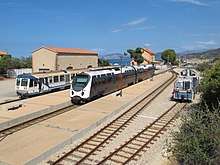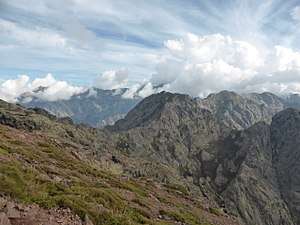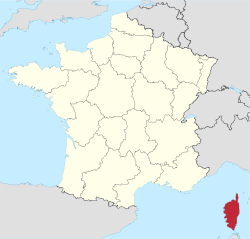Corsica
Corsica (French: Corse, Corsican: Corsica) is an island and a region with special constitutional status of France in the Mediterranean Sea, southeast of mainland France and west of Italy. It is one of the least-visited of the large Mediterranean islands, but has many attractions including historical sights, incredible landscapes and - on the coast at least - a dependably warm and sunny climate for most of the year. The waters around the island offer excellent opportunities for diving and watersports, while inland the mountains draw hikers and climbers. Lastly, visitors come to appreciate Corsica's distinctive and stubbornly separatist culture.
Cities
- 🌍 Ajaccio (Aiacciu) — the chief city of the island, and main port of entry to the southern part. As Napoleon's birthplace, it's well stocked with memorials to the man.
- 🌍 Bastia (Bastìa) — the main city and port of entry in the north. It has a charming old harbour and citadel. It's also the gateway to Cap Corse, the rugged northern peninsula, which includes small communities such as Canari and Nonza.
- 🌍 Bonifacio (Bunifaziu) — at the southern tip of the island, and spectacularly located on cliff tops, this is the port for ferries to and from Sardinia. It's also the access point for Cap Pertusato, the southern tip of Corsica.
- 🌍 Calvi — on the north-west coast, this is a major tourist centre and port with ferries to mainland France. There's an old town with a citadel.
- 🌍 Cargèse (Carghjese) — a village near Ajaccio with a notable physics institute.
- 🌍 Corte (Corti) — the largest inland settlement, has an old town among dramatic mountain scenery.
- 🌍 Saint-Florent (San Fiurenzu) — a small town on the north-west coast between Bastia and Calvi.
- 🌍 Porto-Vecchio (Portivechju) — a pleasant resort town on the south-east coast.
Understand
"Often conquered, never subdued": Corsica has a turbulent history. In the medieval period it was ruled by warring Italian city-states; first Pisa, then Genoa. The island was independent from 1755 before coming under French control in 1768. A separatist movement (re-)emerged in the 20th century, leading to some politically motivated violence. The region now enjoys a special constitutional status within France.
The rugged mountain terrain has deterred industry and large-scale agriculture, and Corsica has suffered comparatively little of the ugly tourist developments that blight other parts of the Med. In fact, Corsican's abundant nature has earned it the nickname île de beauté (island of beauty). It has tourism from France and Italy, but of all the islands in the Med, it's the least-visited by English-speaking tourists. Its main attractions are water-sports (beach, scuba-diving, sailing) and mountain hiking and climbing. The tourist season is fairly narrow, mid-June through August (when booking is essential), although the climate is pleasant May-October. Outside those months many facilities close down, and the mountains become wrapped in clouds and mist.
The official tourist information portal is Visit-Corsica.
Talk
The official language is French. However, Corsica has its own native language, Corsican, which is quite close to Italian. It is estimated that up to 50% have conversational knowledge of Corsican, however everyone has a fluent knowledge of French. Italian is also spoken in tourist areas, but travellers should be wary of whom they address in Italian, due to it being seen as a colonial language.
Few of the islanders speak or even understand English, or other major European languages such as German or Spanish, so some knowledge of French (or Italian - to facilitate understanding of Corsican) may be essential to fully appreciate your time here, depending of course on what you want from your visit. At any rate, it will be polite if you start conversations in French; if locals see you making the effort but realise you're struggling, they will generally be willing to speak more slowly, mime or use any English they do know to help you out!
Get in
By boat
From mainland France, the quickest sailing is the NGV (High Speed Boat, Navire à Grande Vitesse), which takes about 3 hours to sail from Nice to Calvi, l'Île-Rousse, Ajaccio and Bastia. Regular car ferries, taking 6-8 hours, run from Marseille, Nice and Toulon. From Italy, ferries run from Genoa, Livorno, Savona, and Naples; and from Santa Teresa Gallura on Sardinia. The main operator is Corsica Sardinia Ferries, while other companies include La Méridionale and Moby Lines. All these ferry rides give a great view of the mountainous coast on approach, and all the arrival ports are located within towns.
By plane
There are four airports on the island: 🌍 Ajaccio - Napoleon Bonaparte Airport (AJA IATA)., 🌍 Bastia Poretta Airport (BIA IATA)., 🌍 Calvi - Sainte-Catherine Airport (CLY IATA). and 🌍 Figari–Sud Corse Airport (FSC IATA) (near Bonifacio and Porto-Vecchio). These have year-round flights from a variety of airports on mainland France with Air Corsica and Air France. Budget airline services include Easyjet (from Berlin Schönefeld, Euroairport Basel/Mulhouse, Geneva, London Gatwick and Manchester) and Eurowings (from Cologne/Bonn, Dusseldorf, Munich, Stuttgart and Vienna), but they usually only fly June to September. Outside these months, flying from outside France will involve relatively expensive and indirect scheduled flights via Paris CDG; consider instead taking a budget flight to Nice then the ferry to Bastia.
If you don't plan to rent a car on landing, be aware that Corsica's airports lack public transport, except for Bastia which has a bus between town and the airport every hour or two.
Get around

By car
Car is the simplest way to get around this rugged island, as public transport is limited and the hills are formidable. Many people arrive by ferry and take their own car onto the island. Rental cars are available from airports and ferry ports, but do book ahead. Supermarkets do not generally have petrol stations, so make sure you have a decent reserve before embarking on a longer trip. The roads are often twisty and don't allow high speeds, but the road surface is mostly in good repair even in the mountains - except where, all of a sudden, it isn't. Signposting is good, but you may benefit from Satnav in the towns, as traditional little blue French street signs are hard to read from a moving vehicle. Place names are given in French and Corsican: Corsican activists have diligently painted out the French, but you should have no difficulty recognising the Corsican names.
By bus
Buses run along the south-west coast from Ajaccio to Bonifacio and Porto Vecchio, taking 3 hours. In July and August these run three times a day, 7 days a week; the rest of the year it's twice a day, Mon-Sat. Along the east coast they run from Porto Vecchio to Bastia, taking 3 hours. They run twice a day, 7 days a week mid-June to mid-Sept, and Mon-Sat the rest of the year. A same-day connection between Bastia and Ajaccio is possible with a two-hour layover at Porto Vecchio. The operator is Rapides Bleues but a more intelligible timetable is posted on the unofficial website Corsica Bus. The cities have buses to their neighbouring mountain villages, but there's no cross-island bus between Ajaccio and Corte and onward to Bastia - take the train.
By train

France is the land of the sleek TGV, but in Corsica those initials stand for "Train à Grandes Vibrations" - or "U Trinighellu" (the shivering one) as it's locally known. However it's your best public transport option between Ajaccio, Corte and Bastia, as those inter-city buses have been axed.
Trains are run by CF-Corse, a subsidiary of SNCF; investment in 2010 improved the rolling stock and rail infrastructure but it's still a rumbling, rattling ride. The network is non-electrified single track built in metre gauge, twisting and straining across the steep mountain terrain. The network forms a Y-shape: the line runs from Ajaccio north through Corte to the junction at Ponte Leccia, whence the northern branch continues to Bastia while the western branch runs through L'Île-Rousse to Calvi.
CF-Corse provides current timetables in PDF format in French and Corsican. However, these are not posted on Voyages SNCF, so they're not visible to other websites that draw from these, such as Deutsche Bahn. The best English language source is the unofficial website Corsica Bus, which covers all transport modalities. The train between Ajaccio and Bastia takes almost four hours and costs €21.60; there are 6 per day Mon-Fri, 5 Saturdays, 2 Sundays, all direct. Between Bastia and Calvi takes about 3 hours and costs €16.40; there are two trains every day of the week, some with a change at Ponte Leccia. Between Ajaccio and Calvi takes 4.5 hours and costs €25.10, with two trains every day, both with a change at Ponte Leccia.
These are all regional trains - the same as TER in France - so there's no advance booking, just buy your ticket at the station and hop on. The fares cited are full tariff. Some concessions and passes are available, eg the "Pass Libertà" which is €50 for unlimited travel on 7 consecutive days, so you'd have to cover the entire network and return to your start point to benefit. SNCF passes and reductions are not valid in Corsica.
See
As the island was so often fought over, the main towns were heavily fortified. So they typically contain a walled citadel and old harbour, often pedestrianised, and dotted with restaurants and bars. The finest citadel is Bonifacio; arguably the most charming old harbour is Bastia. Ajaccio as the chief city has less old-world charm but has the best museums and galleries.
Do
Water sports are available in all the main ports, e.g. windsurfing and kitesurfing. Scuba-diving is mainly conducted in the south of the island, Porto-Vecchio being a good centre. Expect to pay around €45—€60 for a one-tank dive.
Long distance walking

Corsica has many walking trails. All require the use of topographical maps, despite usually excellent trail marks. IGN maps are the most detailed, and are similar to Ordnance Survey maps in Britain and Ireland. IGN maps may be found in many of the bigger cities, and at the airports, including Bastia airport. Additionally, you can purchase these maps (more expensively) from the internet ahead of time, and in some specialist map shops around the world.
- GR 20 — perhaps the best known and most difficult of all the Grande Randonnée trails. This trail takes approximately 17 days if using the traditional waypoints, though it may take more or less time depending on your experience and needs. The trail is particularly crowded in August; many people suggest the best time is in late spring or early autumn. The greatest danger on the GR 20 arises from the intense summer storms, with lightning claiming the most fatalities.
- Mare e Mare Nord (Sea to Sea North) — Cargèse to Moriani-Plage. Suggested time: 11 days. This trail intersects with the one of the Mare e Monti Trails. The trail is only lightly travelled from Corte to Moriani, as this is the less interesting half, with uniform scenery, and gîtes that may not be open unless you call first.
- Mare e Mare Sud (Sea to Sea South) — Porto-Vecchio to Propriano. Suggested time: 5 days. This is considered an easier trail than the others on the island.
- Mare e Monti (Sea and Mountains) — Calenzana to Cargèse. Suggested time: 10 days. This trail includes the beautiful fishing village of Girolata, which has no road and is only accessible by boat from Calvi or on foot.
Buy
Corsica is well-known for its artisanry, included olive wood-handled knives and jewellery made using a lively red local coral. Local food products such as charcuterie, preserves and biscuits are other commonly-bought souvenir items.
Eat

Corsican food has French and Italian influences, but also has many unique dishes of its own. The chestnut is one of the island's mainstay foods, and is used in many meals and even desserts. Most of the domesticated pigs on the island are semi-wild, released to forage for food for much of the year, and the local charcuterie reflects this excellent flavour. Typical Corsican charcuterie include lonzu, coppa, ham, figatellu and saucisson made from pig or boar meat. Canistrelli are typical Corsican biscuits which come in many different flavours. Corsica also produces a uniquely flavoured olive oil made from ripe fruits collected under trees. Many villages have small shops where locally-produced food is sold. That said, it may be difficult to find a restaurant that prepares true Corsican dishes, and you may find yourself eating at tourist-oriented pizzerias, which nonetheless serve excellent food.
Drink

Corsica has a commercial wine industry, and heritage dating back to the Phoenicians. The techniques employed in Corsica have more in common with Italian than French winemaking traditions. The island has an impressive nine appellations d'origine contrôlée (AOCs), and most wines use nielluccio, sciacarello and vermentino grapes.
Corsicans brew a wide selection of local beers. which have a very distinct taste that you won't find anywhere else in France. It's highly recommended to try "Colomba", "Pietra" or "Bière Torre" when visiting.
Corsica even has its own brand of cola, reflecting its independent ways. Don't be surprised if you are asked "Américain ou corse ?" when ordering a cola. Double points for responding "Corsica-Cola, per piacè!"
Stay safe
Corsica is usually a very safe place, especially for tourists. Going out at night in the towns and villages will not be a problem. Be polite and respectful, and there is nothing to worry about.
Go next
By sea, your choices are as listed in "Get in":
- the French mainland: Nice, Toulon and Marseille;
- the Italian mainland: Livorno and Genoa);
- Sardinia: Santa Teresa Gallura
The route to Sardinia opens up an intriguing mid-Med hopscotch: you could traverse Sardinia to its southern port of Cagliari, from there sail to Palermo in Sicily, and from there onward to Malta or Tunisia, all without returning to the European mainland.
